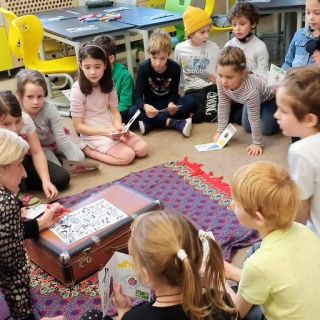
The Museum Comes to You
Museum Pedagogy Workshop
Our museum pedagogical activities represent Asian cultures in a creative way for young people. The rich range of programs related to the exhibitions provides an opportunity to delve deeper into the topic and arouse personal interest. Firstly, our goal during the sessions is to make the participants more sensitive to the given topic and to other cultures. Secondly, education with art is the core of our programmes since we envision art as a mediator between cultures.
The Travelling Museum project was launched in September 2021. We realized that not all the topics in our exhibition appeal to younger people and that for some of them it is difficult to get access to the Museum. The Museum therefore “grabbed its suitcase” and visited more than twenty educational institutions with the aim of introducing the wonderful world of Indonesia to children.
The topics of the sessions were varied. With pre-schoolers, we mapped the flora and fauna of Indonesia with the help of a puppet. We guided schoolchildren into the world of spirits, they created their own good and bad spirits, and we also visited the land of dragons.
The old suitcase also symbolizes the brave female travellers, Ilona Zboray and Júlia Geszty, who visited distant exotic places in the early 1900s. It carries Indonesian objects that the kids could touch, pick up, and try.
The sessions started with the breaking up of a biscuit to show the movements of the continents and the formation of the archipelago. The many falling crumbs were reminiscent of the formation of the islands. Everyone could break a biscuit ritually and eat it. We then made the itinerary: we collected the items what we considered important to pack for the trip. When the day has come, we flew from Budapest to Denpasar, the capital of Bali, with a direct flight by a paper plane. We saw many colourful landscapes from above, we painted the thousand-coloured and wavy Baltic Sea. We created volcanoes, islands, and of course, spirits.
The good and bad spirit of anything could be made. The kids were given a drawing sheet with two plastic eyes glued to it, so they only saw one look on the surface. They had to draw the face of the spirit around the eyes and had to figure out why they drew the good or bad spirit. Usually, good spirits were connected to the children’s family and home, such as the good spirit of their room. And the bad spirits have been linked to things they had difficulties with in their life, for example the bad spirit of basketball. Here we had the opportunity to face the bad spirits, we named them, we portrayed them, they were no longer so scary, they seemed rather funny. We had a good laugh at the evaluation when the kids introduced their spirits in detail.
In terms of age groups, pre-schoolers were the most sensitive, they are still open to new impulses. In their case, the question was whether the session was successful or not. Kindergarten classes were generally successful, and this was obvious from the first moment. If the kindergarteners greeted the educator with love, openness, and helpfulness, it was already half-success to hold the session. If they behaved indifferently, special energy was needed to make the group work together. Pre-schoolers are difficult to take by public transport to a more distant museum since it is tiring for small children. Therefore, the The Museum Goes to You programme could be continued in the future in this age group.
Among schoolchildren, the Museum’s suitcase was most popular among first- and third-graders. There was some difference in the classes held in public or private schools. Classrooms in the public schools are front-facing, so there is little opportunity for movement, relocation, and group work. The children were restrained verbally. In private schools, the classrooms are more centred on the children: there is a play mat, a resting corner, a globe, tables suitable for group work. The children were much bolder in verbal expression, it was good to hear and listen to them. Alternative teaching methods can better develop children’s creative thinking. It was a pleasant disappointment that despite so many online games, the kids’ expressive kills and imagination are still limitless, so we don’t have to worry for now. The children were very interested in getting to know the world of Indonesia.
In the case of the older age group, there was also an example of a session where the class invited us for a specific purpose: their intension was to decorate their classroom, to make it more homely. The session How many feet are you on the ground? Was invented for this occasion and was based on Balinese dances and ceremonies. There will be another project from this idea. Outsourced museum sessions have so far been free as a marketing ploy, but will no longer be free in the future.
We are waiting for your application!
CONTACT
Katalin Szeivolt, museum pedagogue
+36 30 294 9000
katalin.szeivolt@hoppmuseum.hu
Facebook: Kati Keleten




